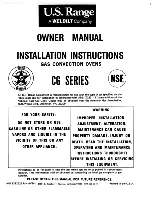
Food
Temperature (°C)
Time (min)
Shelf position
Roast pork 1000 g
160 - 180
90 - 100
2
Roast beef 1000 g
180 - 200
60 - 90
2
Roast veal 1000 g
180
80 - 90
2
Meat loaf, uncooked,
500 g
180
30 - 40
2
Smoked loin of pork
600 - 1000 g (soak for
2 hours)
160 - 180
60 - 70
2
Chicken 1000 g
180 - 200
50 - 60
2
Duck 1500 - 2000 g
180
70 - 90
2
Goose 3000 g
170
130 - 170
1
Potato gratin
160 - 170
50 - 60
2
Pasta bake
190
40 - 50
2
Lasagne
180
45 - 55
2
Misc. types of bread
500 - 1000 g
180 - 190
45 - 50
2
Rolls 40 - 60 g
180 - 210
30 - 40
2
Ready-to-bake rolls
200
20 - 30
2
Ready-to-bake bagu-
ettes 40 - 50 g
200
20 - 30
2
Ready-to-bake bagu-
ettes 40 - 50 g, fro-
zen
200
25 - 35
2
11.8
Baking
• Your oven can bake or roast
differently to the appliance you had
before. Adapt your usual settings
(temperature, cooking times) and
shelf positions to the values in the
tables.
• The manufacturer recommends that
you use the lower temperature the
first time.
• If you cannot find the settings for a
special recipe, look for the one that is
almost the same.
• You can extend baking times by 10 –
15 minutes if you bake cakes on more
than one level.
• Cakes and pastries at different
heights do not always brown equally
at first. If this occurs, do not change
the temperature setting. The
differences equalize during the
baking procedure.
• With longer baking times, you can
deactivate the oven approximately 10
minutes before the end of the baking
time and then use the residual heat.
When you cook frozen food, the trays in
the oven can twist during baking. When
the trays become cold again, the
distortions are gone.
ENGLISH
27
















































